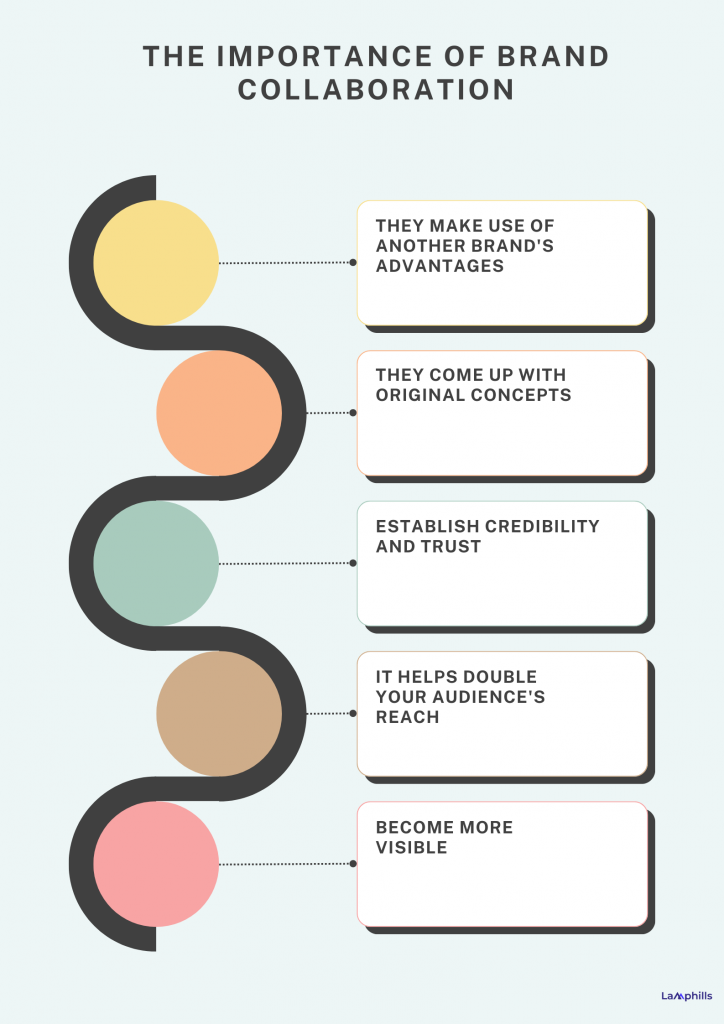I work a lot with marketing and brand strategy and I understand how quickly co-branding and brand collaboration campaigns have grown.
It makes sense: when two brands work together and promote each other, it makes both of them look cool, gets new customers, and creates buzz. When done right, these unexpected relationships interest both customers and the media.
Just look at brilliant examples like Bape’s iconic streetwear collabs with Major League Baseball and Adidas. Or Taco Bell’s surprising team-up with elite beauty brand Sephora. Even Lil Nas X and Tony Hawk joined forces for a must-see skate video! But what are the best brand collaborations in history?
This guide will go over brand partnerships that have made the most noise so far in history. There are clever co-branding partnerships between fashion, entertainment, food, and tech brands that feel new, current, and true to both. But I’ll also talk about why these brand mash-ups worked so well—the marketing strategies, target groups, and strategic goals that made them cultural moments that went viral.
Key Points
- Brand collaborations allow companies to combine resources, knowledge, and strengths to accomplish shared objectives that would be difficult to achieve individually, such as reaching new audiences, improving brand perception, and developing innovative products or services.
- The main reasons for brand collaborations include enhancing brand image and credibility, accessing new markets and audiences, optimizing costs and resources, generating original ideas, and increasing visibility.
- Different types of brand partnerships include sponsorships, cross-promotions, co-branding, and influencer partnerships.
- Successful brand collaborations effectively utilize each partner’s strengths, create authentic connections, spark innovation, engage customers, and align with shared values or purposes.
- To find the right collaboration partners, research audience interests, look for complementary brands with overlap, and define clear objectives.
- Examples of effective collaborations include Kith x Coca-Cola (streetwear meets iconic brand), Adidas x Allbirds (sustainable footwear), and Kendall Jenner x Kylie Cosmetics (fashion meets beauty).
What Is A Brand Collaboration
A brand collaboration is a strategic alliance that aims to accomplish shared objectives between two or more brands. Combining resources and knowledge to develop novel goods, services, or advertising campaigns that capitalize on each brand’s advantages is known as brand collaboration.
Reaching new audiences, improving brand perception, growing market share, and developing distinctive value propositions that would be challenging to accomplish separately are the goals of brand collaboration. This is accomplished by providing unique and inventive goods, services, or experiences that would be difficult or impractical for each brand to launch on its own.
Why Do Brands Partner Together?
Companies work together for a variety of reasons, such as:
#1. Improved Brand Image & Credibility
Collaborating with a respectable influencer or brand can improve credibility and trust while fostering a favourable consumer perception.
#2. Increased Access To New Markets & Audience Reach
By working together, a company can take advantage of the existing customer base of its partner to reach audiences that might not have heard of them before or investigate untapped markets that might be challenging to penetrate on their own.
#3. Optimization of Cost and Resources
Brands may optimize their marketing campaigns, product development, or operational procedures and achieve more noteworthy outcomes with fewer individual investments thanks to shared expenses, resources, and knowledge.
In a supply chain partnership, for instance, two firms can pool their distribution networks, warehousing spaces, and transportation resources, improving logistics and saving costs for both of them.
The Importance of Brand Collaboration
Okay, let’s take, for instance, your favourite company collaborating to create items that feature the best aspects of each of them. similar to what you observe? That is the influence of fruitful brand alliances and teamwork. Partnerships are about more than just making noise; they’re about exchanging knowledge, reaching out to new industries and audiences, and giving clients even more value.

Here are some reasons why brand partnerships are important:
#1. They Make Use of Another Brand’s Advantages
Each business has something special to offer, which is the beauty of a mutually beneficial alliance. By utilizing one another’s advantages, everyone can succeed in their objectives. A company renowned for its uniqueness and innovation could be the ideal partner for a brand with a strong product team but a tiny creative team.
#2. They Come Up with Original Concepts
A brand may experience creative blockages occasionally, but when two brands work together, their styles are combined, and new ideas are generated.
Both brands get access to one other’s PR, social media, and creative teams. This encourages brands to explore new ideas and methods and to widen their horizons.
#3. Establish Credibility and Trust
If you appreciate a brand and it collaborates with another brand, you can think, “Well, maybe I should too, if brand A trusts them!” Through partnerships, lesser-known brands can reach a wider target market.
You are more inclined to try something new if your favourite brand partners with one you haven’t tried before. It’s similar to your friend endorsing a new person.
#4. It Helps Double Your Audience’s Reach
Every brand has a devoted following of its own. When two brands collaborate, they can access each other’s consumer base. Both brands benefit from being in the spotlight together.
#5. Become More Visible
When two businesses work together, people take note. The excitement goes viral as they post about it on social media and discuss it with friends. Regular product introductions struggle to match the buzz created by this.
Techniques for Locating Partners for Collaboration
It can be difficult to decide how to collaborate with brands. A few things should be in mind if you’re considering working on a collaborative project. Here are some tips to assist you in selecting the ideal partners for your brand partnerships.
#1. Examine Beforehand
Social media is a fantastic way to gauge how interested your audience is in possible co-branded events or merchandise. You may determine which aspects of cooperation to focus on and which to cut by using social listening. Try hinting at a partnership with a brand that’s interested and gauge the reaction from your audience.
#2. Look for Complementing Brands that Your Target Market is Familiar With
Always make an effort to concentrate on potential commonalities with other people. Determine your target audiences’ associations with your brands, and don’t be scared to take risks that you might on a solo campaign. Perhaps the emotions your product arouses, the common interests your audiences have, or the priorities of your target market are the focal points of your ideal collaboration.
#3. Determine Your Objectives for Working Together
Setting goals is the first step towards achieving any kind of success, be it more sales or broader reach. From there, your brand can connect with partners who complement it inside your sector or target market. If you’re considering launching an influencer marketing campaign, you might want to use the Five Ws + H framework to help you plan across the customer journey and calculate return on investment.
Types Of Brand Partnerships
When thinking about a strategic relationship, you might find a few different kinds of brand collaboration interesting.
So let’s look at them:
#1. Sponsorship
Sponsorship is a brand partnership in which a firm donates resources or funds to another business, such as a sports team or nonprofit. In exchange, the sponsoring brand gains visibility, branding possibilities, and access to the audience of the sponsored partner, all of which strengthen linkages between the brand and a specific cause or activity.
#2. Cross-Promotion
When two or more brands work together to market one other’s goods and services and reach new markets, they engage in cross-promotion. They usually use discounts, bundled offerings, cooperative marketing initiatives, or combined advertising efforts to achieve this.
#3. Co-branding
Co-branding is a type of brand partnership in which two or more companies work together to develop and promote a distinctive product that appeals to a common target market.
#4. Influencer Partnerships
Influencer partnerships are brand alliances in which a well-known person or social media influencer endorses the goods or services of the brand. This kind of partnership boosts brand recognition and sales by using the influencer’s reach, credibility, and influence.
Examples of Effective Brand Collaborations
It’s one thing to recognize the benefits of brand partnerships; it’s another to evaluate their effectiveness.
These are actual instances of times when companies have collaborated, produced unique goods, and started customer-memorable campaigns.
#1. Kith and Coca-Cola
Streetwear company Kith partnered with globally popular beverage company Coca-Cola. The outcome was a limited-edition collection of clothing and accessories that combined Kith’s urban aesthetic with the recognizable Coca-Cola logo and colours.
Reasons for their Collaboration
- Unexpected combination: A fashion brand and a beverage firm are not often seen together. Excitement and curiosity were created by this surprising combination.
- Iconic imagery: The goods appealed to lovers of both companies since they used the iconic Coca-Cola logo and Kith’s contemporary style.
- Restricted availability: The partnership generated a sense of urgency and exclusivity by launching limited-edition products.
Impactation
- Versatility of branding: The partnership demonstrates the influence and flexibility that legendary branding—like Coca-Cola’s—can have when applied to new situations.
- Appeal to a wide range of consumers: Combining streetwear with a globally recognizable brand ensured that the partnership reached various audiences.
- Demand is driven by scarcity: Products with limited releases like this can pique consumers’ interests and generate buzz.
#2. Adidas and Allbirds
Allbirds, renowned for its eco-friendly footwear, and Adidas, a global sportswear leader, created a sneaker with a remarkably low carbon footprint.
The first pair of Futurecraft Footprint sneakers were thought to be the world’s most environmentally friendly. The new shoes had a reduced carbon footprint than a typical pair of Adidas sneakers, with only 2.94 kg of CO2 emissions per pair, compared to an average of 10 and 15 kg.
Reasons for their Collaboration
- Similar vision: Adidas and Allbirds shared a dedication to sustainability. Although the two brands had different approaches to shoemaking, they worked together to lessen the impact on the environment.
- Complementary specialities: Allbirds provided its own understanding of sustainable materials and production techniques, while Adidas added decades of experience designing sportswear to the partnership.
- Authenticity: This partnership was more than a marketing ploy in a market where customers are growing more ecologically conscientious. Customers were moved by the project’s sincere intentions.
Impactation
- Purpose over profit: Although partnerships frequently seek to increase sales, in this case, sustainability was the main goal, underscoring the significance of purpose-driven alliances.
- Innovation can be sparked by partnerships: Adidas and Allbirds expanded the possibilities for sustainable footwear by pooling their knowledge.
- Customer engagement: Genuine partnerships that address contemporary issues worldwide can strike a deep chord with customers and increase brand loyalty.
#3. West Elm and Leesa
A good mattress is necessary for a good night’s sleep, and West Elm immediately comes to mind when considering fashionable bedroom furnishings.
Reputed for its high-end mattresses, Leesa and popular modern furniture retailer West Elm decided to collaborate. The objective was straightforward: establish a space where buyers could test out Leesa mattresses in the stylish context of West Elm’s furniture collection.
Reasons for their Collaboration
- Try before you buy: West Elm locations offer a location where clients can personally feel the comfort of Leesa mattresses, simplifying buying decisions.
- Design synergy: Leesa’s contemporary mattress style gave a unified appearance when combined with West Elm’s elegant furnishings.
- Shared values: Customers concerned about the environment were drawn to both brands’ dedication to social responsibility and sustainability.
Impactation
- Experience is key: Providing customers with an opportunity to test a product in an authentic environment can increase sales and foster trust.
- Aligned brand values are important since they make collaborations more authentic and smooth when the two brands have comparable guiding principles.
- Strength in unity: By combining their knowledge and resources, Leesa and West Elm offered a comprehensive solution for comfort and style.
#4. Kendall Jenner and Kylie Cosmetics
Something exceptional is about to happen when two industry titans in beauty and fashion collaborate on a marketing campaign. That was precisely the situation with Kendall Jenner and Kylie Cosmetics’ partnership.
Kendall Jenner, a global fashion queen, and Kylie Cosmetics, recognized for their revolutionary beauty products, decided to combine their worlds. What was the outcome? a line of wearable and highly fashionable makeup.
Reasons for their Collaboration
- Family ties: Kylie and Kendall Jenner are sisters and well-known figures in the fashion and beauty industries. This personal connection gave the project a special touch and authentic feeling.
- Balancing acts: Kendall is renowned for her more natural and subtle style, while Kylie’s brand frequently tends toward bright and aggressive colour schemes. They achieved a balance between them that drew in a diverse group of beauty enthusiasts.
- Built-in fanbase: The partnership attracted a lot of attention because both Jenner sisters have sizable fan bases. Supporters of both ladies were eager to see what their collaboration would produce.
Impactation
- Genuine relationships, such as those forged via family, are a great foundation for collaborations because they resonate more deeply with customers and give them a sense of personalization and exclusivity.
- Making the most of combined strengths: The collection caters to those who enjoy dramatic and delicate makeup by fusing Kendall’s fashion-forward style with Kylie’s competence in makeup application.
- Anticipation is a strong tool. When two prominent people make suggestions about working together, a great deal of buzz and enthusiasm can build up, which can help the project succeed when it launches.
#5. Chubbies and the Jurassic Park
Jurassic Park, a popular movie series, and Chubbies, the brand that customers choose for fun-filled novelty clothes, have partnered together. The result was nothing short of a fashion journey: a brand that expertly merged the reckless attitude of Chubbies with the adventurous spirit of Jurassic Park.
Reasons for their Collaboration
- Factor of surprise: The unusual combination caught people’s attention because it wasn’t your usual working together. The question “Dinosaurs on shorts? “sparked interest. This needs to be seen!
- Nostalgia: Chubbies’ whimsical appearance, combined with the fond memories and feelings that Jurassic Park conjures for many people, developed a new yet nostalgic appeal.
- Wide appeal: Jurassic Park helped Chubbies reach more moviegoers and individuals searching for distinctive pieces, whereas Chubbies targeted a specific style group.
Impactation
- Dare to be unique: Unusual partnerships can help firms stand out and attract attention in a crowded industry.
- Reach a wider audience by tapping into similar audiences: Separate brand identities can be combined to reach a wider range of consumers.
- Maintaining consistency in branding is essential. This ensures that, even with the distinctive character of the cooperation, the primary supporters of both brands stay involved.
Why do people love brand collaborations?
Consumer perception of a brand can also be improved by partnering with another respectable company. Consumers are more willing to interact with brands they already trust, increasing customer loyalty and conversion rates.
What is the difference between co-branding and brand collaboration?
There is always a shared good, service, or experience with co-branding. Conversely, brand collaboration does not always have to result in a product. It can take many different forms, such as cooperative marketing or combined support of philanthropic organizations.
How do you plan a brand collaboration?
- Establish Specific Goals. Specify the objectives you hope to accomplish with the potential brand collaboration.
- Determine Possible Partners.
- Describe the scope.
- Create a plan, execute a contract, schedule cooperative marketing initiatives, etc.
- Distribute Resources
- Implement & Track.
How do clothing brands collaborate?
In its basic form, collaborative marketing is when two brands work together to develop a special product that combines aspects from each of their worlds. They then collaborate to create a campaign to market the finished product.
What are the four 4 ways to build collaboration?
Evaluate your culture’s level of inclusivity. Work to promote empathy among team members in order to facilitate the development of an inclusive culture. Third, place more emphasis on listening to comprehend than hearing to react. Fourth, spend some time investigating the components of honest, actionable feedback.
Do Gen Z like brand collaborations?
Generation Z’s curiosity about unexpected brand collaborations is another noteworthy trend.
What makes a successful brand collaboration?
Customers and brands alike should benefit from a successful brand relationship. You must provide something special, pertinent, and advantageous to both sides.
Do brand collaborations increase sales?
Diverse forms of brand collaboration have distinct prospects for expansion, visibility, and heightened revenue. Brands can access new markets, attract new consumers, and develop distinctive products or campaigns that are more compelling and memorable when they collaborate rather than trying to do it alone.
Conclusion
Collaborating with brands can be a great method for businesses to reach new customers and develop cutting-edge products. These partnerships are just a few instances of how two companies from different sectors may work together to produce something special. Whether it’s a branded skateboard or a highly pigmented matte lipstick, these collaborations show what can be done with imagination and inventiveness.
Related Articles
- 7 Simple Practical Steps to Build Brand Loyalty
- Different Types of Influencers And How To Determine Which One You Need
- How Much Do Social Media Influencers Make? Income Breakdown
- How to Write News Releases: Free Tips and Examples
- PR for B2B Companies: Tailoring Your Approach to Reach Decision-Makers





